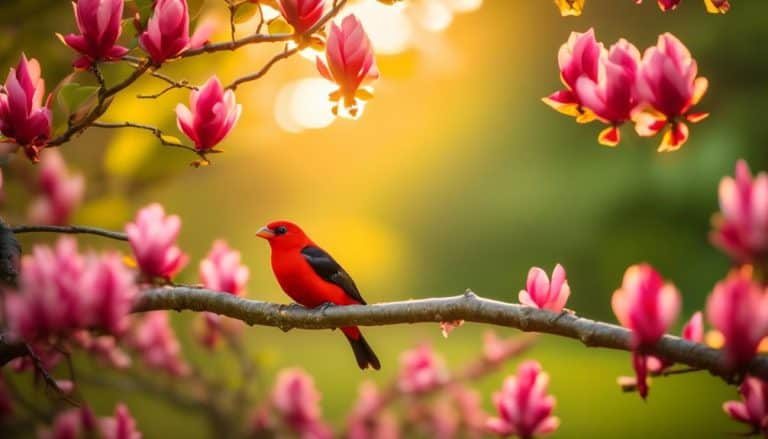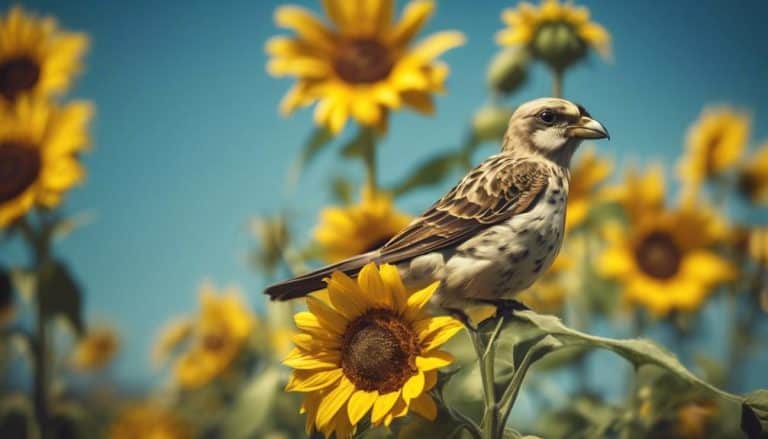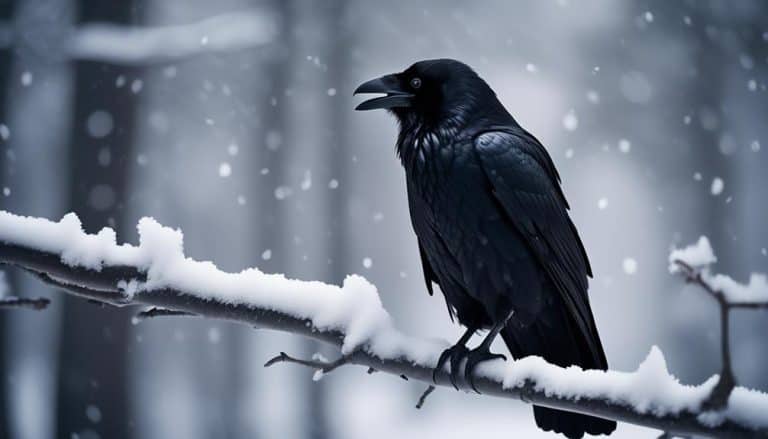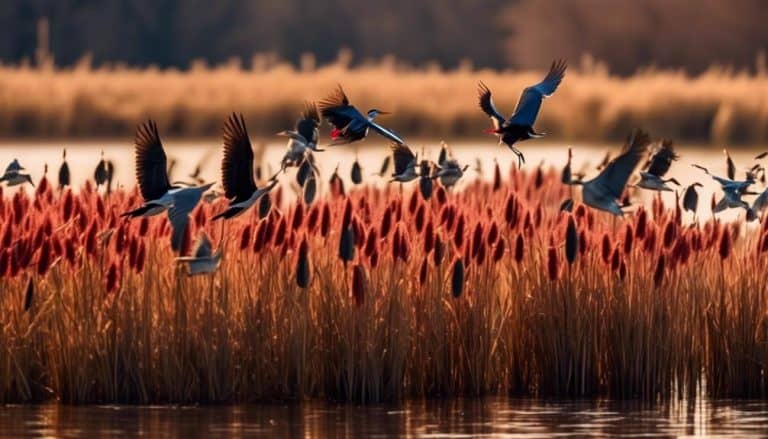As I stand here, gazing into the vast blue sky of Illinois, I can't help but wonder: what secrets do the blue birds hold in their wings? These beautiful creatures, with their vibrant plumage and melodious songs, have captured the imaginations of bird enthusiasts for generations. But what do we really know about them?
How do they adapt to the diverse habitats of this state? And what can we do to ensure their survival? Join me as we uncover the mysteries of blue birds in Illinois, exploring their species, habits, and the tireless efforts of conservationists to protect them.
Species of Blue Birds in Illinois

In Illinois, there are three species of blue birds that can be found: the Eastern bluebird, the Mountain bluebird, and the Western bluebird. These species exhibit interesting migration patterns and have distinct population trends in the state.
The Eastern bluebird (Sialia sialis) is the most common bluebird species found in Illinois. They're cavity nesters and often utilize man-made nest boxes for breeding. Eastern bluebirds are migratory birds, with their migration patterns varying based on weather conditions and food availability. They typically migrate south during the winter months and return to Illinois in early spring to breed.
The Mountain bluebird (Sialia currucoides) is a rare visitor to Illinois. This species is primarily found in western and northern parts of North America. Mountain bluebirds have a more extensive migration pattern, traveling long distances during the winter months to southern states and Mexico. Their population in Illinois is sporadic, with occasional sightings during spring and fall migration.
The Western bluebird (Sialia mexicana) is another rare visitor to Illinois. This species is primarily found in the western United States. Western bluebirds also have a migratory behavior, similar to the Mountain bluebirds, with their population trends in Illinois being unpredictable.
Understanding the migration patterns and population trends of these bluebird species in Illinois is vital for conservation efforts. Monitoring their presence and abundance can provide valuable insights into the health of their habitats and overall ecosystem.
Habitat Preferences of Blue Birds
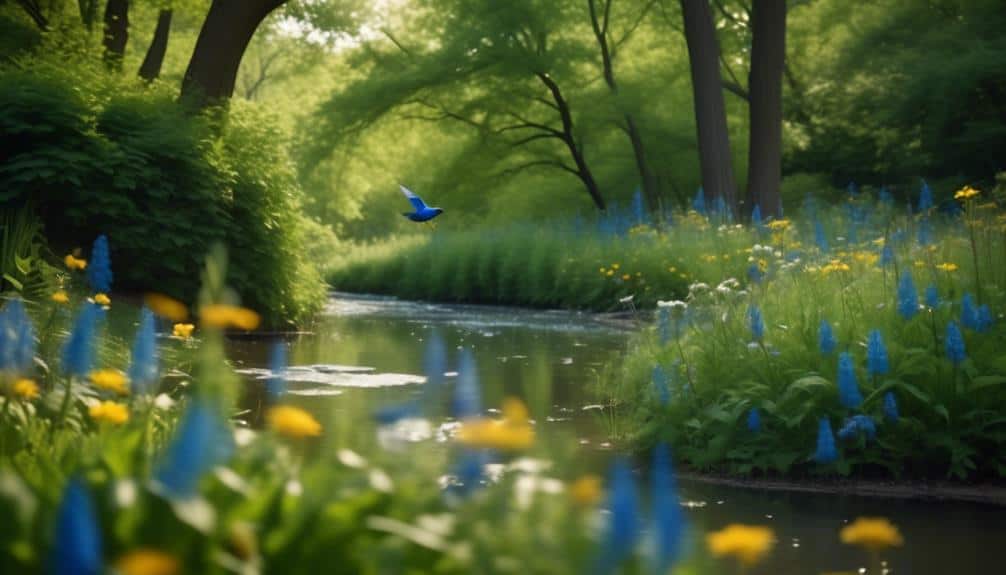
The blue birds in Illinois exhibit distinct habitat preferences that play a crucial role in their survival and reproductive success. Understanding these preferences is essential for conserving and promoting the well-being of these beautiful creatures. Here are three key factors that influence the habitat preferences of blue birds in Illinois:
- Nesting Behaviors:
Blue birds prefer open habitats with scattered trees and shrubs, as these provide suitable locations for their nests. They often choose nest boxes or natural cavities in trees, particularly those with entrances facing away from prevailing winds. These nesting sites offer protection from predators and provide a safe environment for raising their young.
- Food Sources:
Blue birds in Illinois primarily feed on insects, especially during the breeding season. They have a strong preference for open areas with short grass, where they can easily spot and capture their prey. Meadows, pastures, and open fields provide an abundant supply of insects, making these areas ideal for blue birds to forage.
- Water Sources:
Blue birds require access to water for drinking and bathing. They are often found near bodies of water such as streams, ponds, or shallow birdbaths. These water sources not only fulfill their hydration needs but also attract insects, which serve as an additional food source.
Breeding Habits of Blue Birds
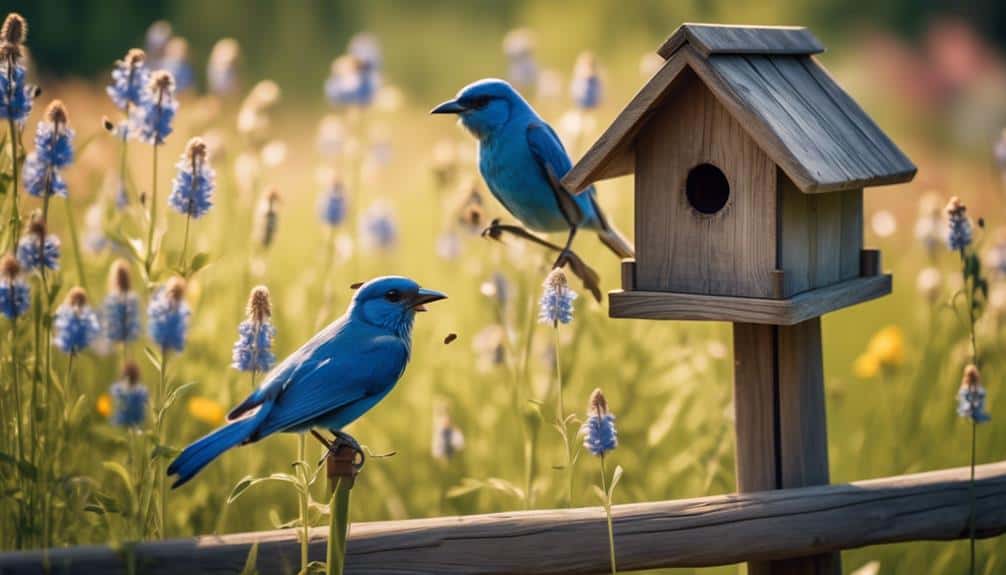
Blue birds in Illinois exhibit fascinating breeding habits that involve intricate courtship displays and precise nest-building behaviors. Understanding blue bird nesting behavior is crucial to conserving their populations and ensuring their successful reproduction.
Blue birds typically breed once or twice a year, with the peak breeding season occurring from April to July in Illinois. During this time, male blue birds engage in elaborate courtship displays to attract females. These displays involve flapping their wings, puffing up their feathers, and singing melodious songs.
Once a pair forms, they begin the process of nest-building. Blue birds are cavity nesters, meaning they build their nests in pre-existing cavities such as tree hollows or nest boxes. They're known for their exceptional nest-building skills, constructing tight and secure nests using a combination of fine grasses, pine needles, and feathers. The female blue bird takes the lead in nest building, while the male assists by bringing additional nesting materials.
Interestingly, blue birds in Illinois demonstrate migratory behavior, with some individuals choosing to migrate to warmer regions during the winter months. Migratory patterns of blue birds vary, with some individuals migrating short distances within Illinois, while others may travel much farther to southern states or even Mexico. This migratory behavior is influenced by factors such as food availability and temperature.
Studying the breeding habits and migratory patterns of blue birds in Illinois provides valuable insights into their reproductive success and population dynamics. By understanding and conserving their nesting behavior and providing suitable habitats, we can ensure the long-term survival of these enchanting birds in Illinois.
Conservation Efforts for Blue Birds
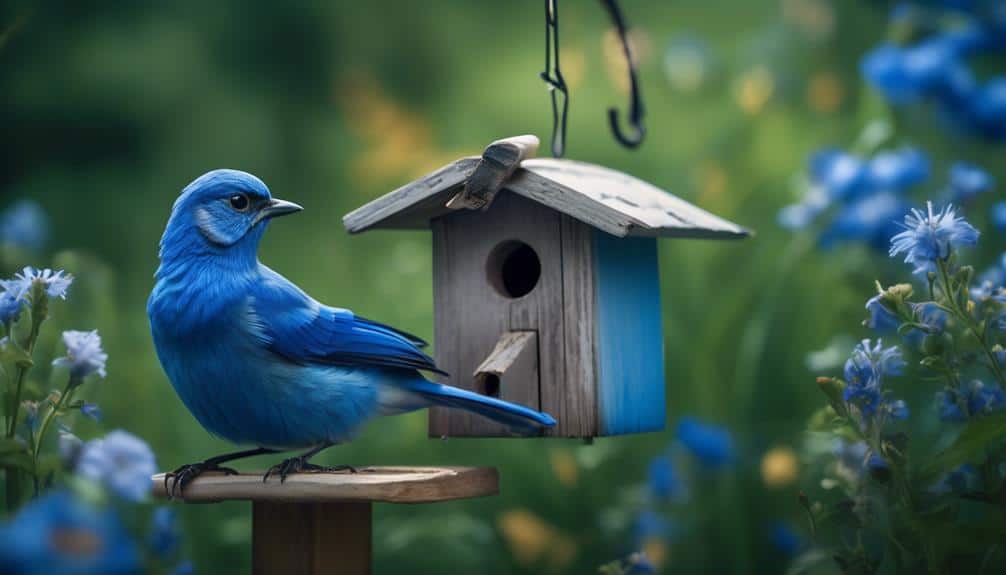
Efforts to conserve the populations of blue birds in Illinois have been implemented through a combination of habitat restoration, nest box programs, and public awareness campaigns.
Habitat Restoration: Restoration projects aim to create and maintain suitable nesting and foraging habitats for blue birds. This involves planting native vegetation, maintaining open grasslands, and reducing the use of pesticides that can harm blue birds and their food sources.
Nest Box Programs: Nest boxes provide artificial nesting sites for blue birds, which are essential due to the loss of natural nesting cavities. These programs involve installing and maintaining nest boxes in suitable locations, monitoring their use, and providing supplementary food during harsh weather conditions.
Public Awareness Campaigns: Raising awareness about the importance of blue birds and their conservation is crucial for their long-term survival. These campaigns educate the public about the decline in blue bird populations, the role of habitat preservation, and ways individuals can contribute, such as participating in citizen science programs or creating bird-friendly gardens.
Blue Bird Watching Tips in Illinois
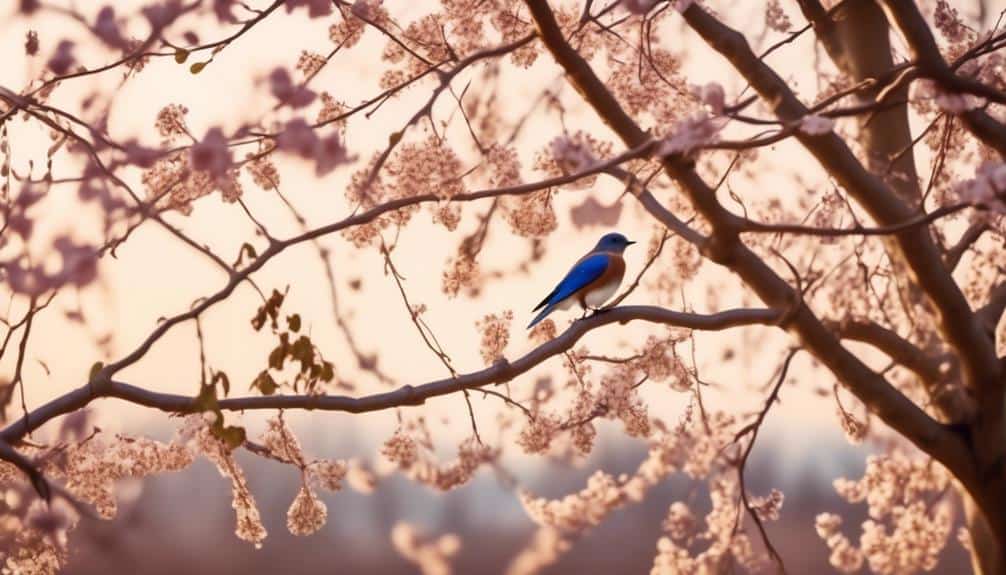
After learning about the conservation efforts for blue birds in Illinois, I have compiled a list of helpful tips for blue bird watching in the state. Blue birds are known for their beautiful plumage and melodious songs, making them a favorite among bird enthusiasts. To maximize your chances of spotting these stunning creatures, it is essential to understand their migration patterns and know the best locations for blue bird sightings in Illinois.
Blue bird migration patterns in Illinois typically occur in the spring and fall. During these times, these birds travel long distances in search of suitable breeding grounds and food sources. To increase your chances of observing blue birds during migration, it is recommended to visit areas near water bodies, as they provide essential resources for these birds during their journey.
Here is a table that highlights the best locations for blue bird sightings in Illinois:
| Location | County | Additional Information |
|---|---|---|
| Starved Rock State Park | LaSalle | Offers diverse habitats and attracts various bird species. |
| Illinois Beach State Park | Lake | Features dunes, wetlands, and forests, ideal for birdwatching. |
| Shawnee National Forest | Union, Jackson | Home to a wide range of bird species, including blue birds. |
| Crab Orchard National Wildlife Refuge | Williamson | Provides a suitable habitat for migratory birds. |
Interesting Facts About Blue Birds in Illinois
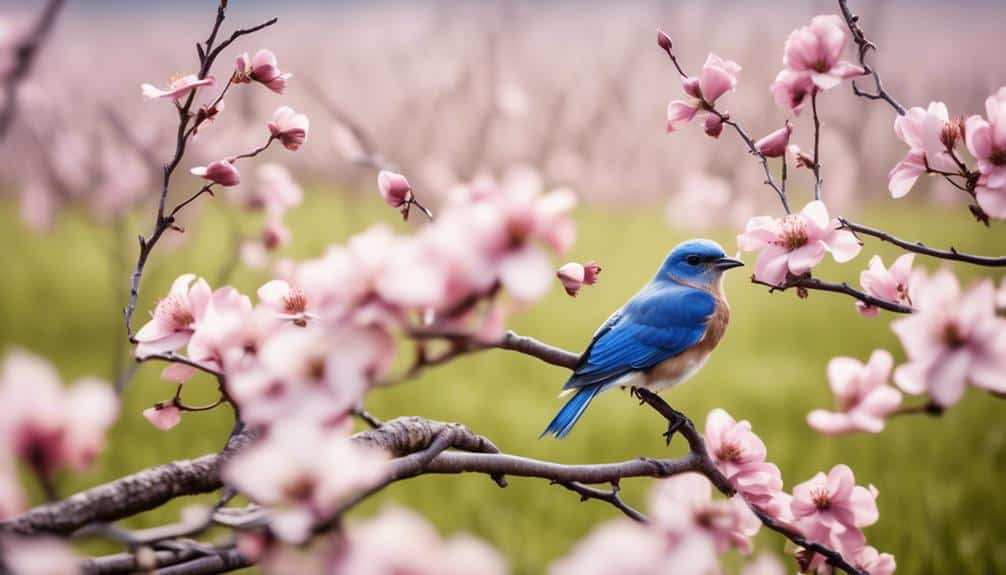
During my observations of blue birds in Illinois, I've discovered several interesting facts about these captivating creatures. Here are three fascinating tidbits about blue birds in Illinois:
- Blue Bird Migration Patterns: Blue birds in Illinois are migratory birds, meaning they travel long distances during certain times of the year. They typically migrate to southern states such as Texas and Florida during the winter months to find more abundant food sources and milder climates. In the spring, they return to Illinois to breed and raise their young.
- Blue Bird Diet and Feeding Habits: Blue birds in Illinois have a varied diet that consists mainly of insects, including beetles, grasshoppers, and caterpillars. They're also known to eat small fruits and berries when insects are scarce. Blue birds are skilled hunters, and they often perch on branches or fence posts, scanning their surroundings for potential prey. Once they spot a target, they swoop down and snatch it up with their sharp beaks.
- Nesting Habits: Blue birds in Illinois are cavity nesters, meaning they build their nests inside tree cavities or nest boxes. They prefer open areas with scattered trees, where they can easily find suitable nesting sites. Blue birds are known to be territorial, and they'll defend their nests fiercely against intruders, including other blue birds. They lay several eggs in their nests, and both the male and female take turns incubating the eggs and feeding the hatchlings.
These interesting facts provide a glimpse into the lives of blue birds in Illinois, shedding light on their migration patterns, diet, and nesting habits. Studying these captivating creatures can help us better understand and appreciate their role in the ecosystem.
Frequently Asked Questions
How Do Blue Birds in Illinois Communicate With Each Other?
Blue birds in Illinois communicate through vocalization patterns and visual signals. They use various calls and songs to communicate with each other, while also relying on visual displays such as wing waving and tail flicking.
Are Blue Birds in Illinois Affected by Climate Change?
Blue birds in Illinois, like other bird species, are undoubtedly impacted by climate change. It is crucial to implement effective conservation efforts to safeguard their habitat and ensure their survival in the face of changing environmental conditions.
What Is the Average Lifespan of Blue Birds in Illinois?
The average lifespan of blue birds in Illinois is around 6-10 years. They rely on a diet of insects and berries, and are skilled nest builders, using materials like grass and feathers.
Do Blue Birds in Illinois Migrate During the Winter?
Yes, blue birds in Illinois do migrate during the winter. They seek warmer habitats in the southern regions where they can find food and suitable nesting sites to ensure their survival during the colder months.
How Can I Attract Blue Birds to My Backyard in Illinois?
To attract blue birds to my backyard in Illinois, I have created a bluebird friendly habitat. I provide them with proper nesting boxes, a water source, and a variety of native plants for food.
Conclusion
In conclusion, the blue birds of Illinois are truly a marvel to behold. With their vibrant plumage and melodious songs, they bring life and joy to the state's landscapes.
Their habitat preferences and breeding habits make them a unique and fascinating species.
Thanks to conservation efforts, their populations are being protected and their future secured.
So grab your binoculars and head out to the great outdoors of Illinois, where you can witness the mesmerizing beauty of these enchanting blue birds.

